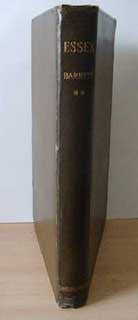Cat No.: IE5099:
First published in 1893 by Lawrence and Bullen of London and republished here on fully-searchable CD-Rom is the first edition (second series) of Essex: Highways, Byways and Waterways. Containing 254 pages Barrett provides 114 pen-and-ink sketches throughout the text mainly to provide 'antiquarian detail', whether it be of wood, stone or metal.
Written and illustrated by Charles Raymond Booth Barrett, conspicuous for his publications on the Royal Hussars and Society of Apothecaries, Barrett had published the first series of Essex Highways and Byways in 1892, but had quickly realised that his tour of the county had generated so much information that he could quickly bring a second edition - series - to press and started writing this before the release of the first. The first series witnessed the author touring the small towns and boroughs of Essex. This publication sees him touring some of the smaller villages and hamlets and the various stately homes and manor houses, both resplendent and ruinous. Barrett begins his tour in the village of Newport and travelling in a circular direction - by train it is assumed as one of his credits goes to the general manager of the Great Eastern Railway - west to east, finishing at Harlow.
Of the resplendent manor houses left unchanged by time were those of Faulkbourne Hall and Ingatestone, while others such as D'Arcy Hall and Rayne were in a state of some decay and yet others, notably Rochford, Netherhall, Beckingham, Dorewards and Rickling were in a most parlous state. Special attention was paid by the author, not unnaturally, to Waltham Abbey and the priory of St. Osyth.
Starting at Newport, Barrett describes the village in peculiar detail, debunking the possible myth that Nell Gwynn lived for a time here, before moving on to Wicken-Bonhunt and Arkesden. At the former place, standing in front of the new house known as Bonhunt Farm is a dilapidated little chapel, with a tiny nave and chancel. Possibly vaulted, the author attempted to gain access, but the small chapel, probably of Norman origin, was in such a state of disrepair that it was feared that it could collapse at any moment; and so Barrett moved on, next to Rickling and Finchingfield and then to Panfield, Bocking and Braintree. Ending his perambulations at Harlow the reader is left with a desire to learn more about the antiquities and ancient architecture of Essex.
A very readable and wonderfully-illustrated book that must certainly recall a county that has changed beyond all recognition in the century that has passed since Barrett undertook his tour. Fully-indexed, this publication is heartily recommend to anyone interested in the history, myth, legend and architecture of the Essex.
No. of CDs is: 1 ; Format is: PDF ; Searchable?: YES;
FastFind: No; ISBN No.: unavailable;


